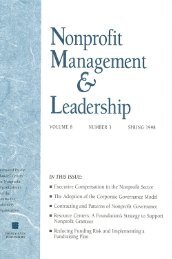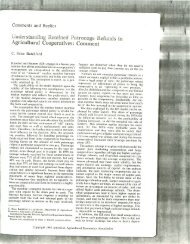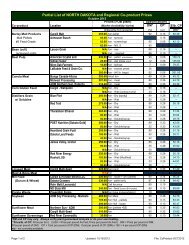Sunflower Production Field Guide - Your "Home Page"
Sunflower Production Field Guide - Your "Home Page"
Sunflower Production Field Guide - Your "Home Page"
You also want an ePaper? Increase the reach of your titles
YUMPU automatically turns print PDFs into web optimized ePapers that Google loves.
24<br />
cially if the moisture stress occurs before the crop is in<br />
the reproductive stages. In limited-moisture growing<br />
seasons, sunfl ower following a shallower rooted and<br />
short-season crop (e.g., small grain, canola, fl ax) will<br />
allow the sunfl ower to extract residual water from a<br />
greater depth in the soil profi le.<br />
Continuous cropping of crops such as corn, wheat and<br />
soybeans results in yields that are depressed below<br />
the level obtained when a crop is rotated with other<br />
crops. The same effect is observed with sunfl ower,<br />
even when variable factors such as fertility, disease,<br />
insects and moisture are well-managed. This response<br />
with continuous cropping is known as allelopathy.<br />
Toxic materials in the sunfl ower residue, development<br />
of antibodies and the increase of soil-borne disease<br />
organisms all have been suggested as causes for<br />
allelopathy in sunfl ower. This effect has been demonstrated<br />
repeatedly and emphasizes a need to rotate<br />
sunfl ower.<br />
Suggested sunfl ower rotations for North Dakota<br />
will vary somewhat by geographic region, primarily<br />
because of different precipitation zones. For practical<br />
purposes, the state can be divided into east and west<br />
regions. Suggested rotations for these regions are<br />
listed in Table 11. Rotations may be varied by substituting<br />
other crops in the rotation, but the time spacing<br />
of the sunfl ower crop should be observed strictly or<br />
increased. See NDSU Extension Service publication<br />
EB-48, “Crop Rotations for Increased Productivity,”<br />
for additional details on crop rotation.<br />
Table 11. Sunfl ower rotation examples for North Dakota.<br />
Year West East<br />
Pollination<br />
(Gary Brewer)<br />
1 Sunfl ower Sunfl ower Sunfl ower Sunfl ower<br />
2 Small grain Pulse crop* Soybean* Small grain<br />
3 Pulse crop* Small grain Small grain Soybean *<br />
4 Flax or small grain Corn<br />
*medium susceptibility to Sclerotinia.<br />
Native sunfl ower and the early varieties of sunfl ower<br />
were self-incompatible and required insect pollination<br />
for economic seed set and yields. However, because<br />
numbers of pollinators were often too low to ensure<br />
adequate seed set, current hybrids have been selected<br />
for and possess high levels of self-compatibility.<br />
Although self-compatible sunfl ower hybrids usually<br />
outproduce self-incompatible cultivars, modern<br />
hybrids benefi t from insect pollination.<br />
The agronomic value of insect pollinating activities to<br />
current hybrids varies among hybrids, fi elds and years.<br />
Controlled studies indicate that in most sunfl ower<br />
hybrids, seed set, seed oil percentage, seed yields and<br />
oil yields increase when pollinators (primarily bees)<br />
are present. Literature reports indicate that yield could<br />
increase as much as 48.8 percent and oil percentage<br />
could increase 6.4 percent in bee-exposed hybrids.<br />
However, despite the increases in yield and oil concentration<br />
that occur, the benefi t of insect pollination<br />
of sunfl ower often is overlooked (Figure 15).<br />
Seed companies and growers who produce F1 hybrid<br />
seed for planting must use bees to transfer pollen from<br />
the male parent to the female parent. Although native<br />
wild bees are often better pollinators of sunfl ower<br />
than honey bees, the honey bee is the only managed<br />
pollinator of sunfl ower available. However, if pollen<br />
sources other than sunfl ower are nearby, the honey bee







